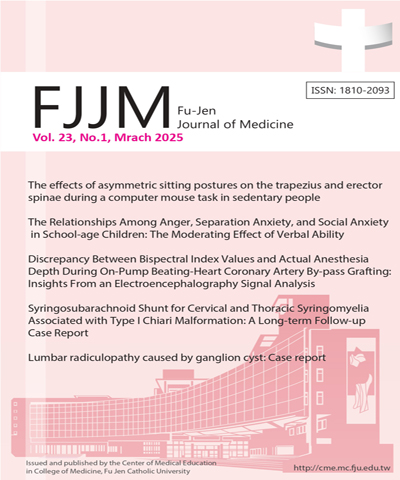
輔仁醫學期刊/Fu-Jen Journal of Medicine
輔仁大學醫學院,正常發行
選擇卷期
- 期刊
Background and purpose: Ulnar shortening osteotomy for symptomatic positive ulnar variance with Tolat's type Ⅲ distal radioulnar joint (DRUJ) and radial shortening for treating Kienböck's disease in the wrist of negative ulnar variance with type II DRUJ have been noticed to have increased risk of post- operative DRUJ osteoarthritis. The purpose of our study was to indentify various configurations of DRUJ relating to the ulnar variance and determine their prevalences in our population with special attention to these two potentially problematic configurations. Methods: The standard posteroanterior view of 264 normal adult wrist radiographs were reviewed. The sigmoid notch obliquity angle was measured and the cut-off values to determine the Tolat's type were defined at 5 drgress either facing proximal or distally. The DRUJ was further classified by adding ulnar variance to the original Tolat's classification system. Results There were 8 radiographic types of DRUJ. The prevalences of the potentially problematic types I Ⅱc(proximally facing radial sigmoid notch with negative ulnar variance) and Ⅲb(distally facing radial sigmoid notch with positive ulnar variance) were 8.3% and 11.4% respectively. The females had much higher prevalence of type Ⅲb than males. Conclusions: A total of 19.7% of our adult wrists are with one of these two problematic types of DRUJ which limit the length of correction and require prudent preoperative planning when surgeries altering the ulnar variance become indicated. Special attention is recommended for the females as they have much higher prevalence of type Ⅲb than the males.
- 期刊
Background and Purpose: To investigate the foveal contour (FC) in advanced retinopathy of prematurity (ROP) following intravitreal bevacizumab or laser treatment. Methods: From January 2002 to August 2011, we collected patients with type 1 ROP treated by monotherapy of intravitreal bevacizumab or peripheral retinal diode laser photocoagulation. The cases were examined by macular spectral-domain optical coherence tomography, cycloplegic refraction, and best corrected visual acuity (BCVA). Abnormal FC, that is, incomplete fovealization was defined as retention of inner retina structures, including retinal ganglion cell, inner plexiform, and inner nuclear layers. The gestation age, birth body weight, postmenstrual age for treatment, foveal contour, treatment regimen, fundus findings, and follow-up periods were recorded by chart review. Results: We collected 19 patients (38 eyes) with type 1 ROP, including 14 male and 5 female infants. Laser treatment was administered in 15 patients, and bevacizumab injection for 4 infants. After mean follow-up period of 98.3 months, all had favorable anatomical outcome following single session of laser or injection treatment. Of these infants, 24 (63.2%) eyes owned abnormal FC and 14 (36.8%) with normal FC. No significant difference was found between normal and abnormal FC groups in various clinical factors except for postmenstrual age of treatment (p = 0.002). There was a trend that patients with abnormal FC were associated with smaller gestational age (p = 0.05), more zone 1 disease (p = 0.06), poorer BCVA (p = 0.09), and thicker central foveal thickness (CFT) (p = 0.09). Conclusion: All the patients with advanced ROP treated by bevacizumab or laser therapy had favorable anatomical structure. Abnormal FC could be found in nearly two-thirds of the cases. Incomplete fovealization had correlation with younger baby, more immature retina, earlier postmenstrual age of treatment, poorer BCVA, and thicker CFT.
- 期刊
Background and purpose: Midgut malrotation and volvulus are rare in infants and difficult to diagnose preoperatively . Ultrasound diagnosis has the advantage of no radiation exposure. Color Doppler documenting the reversal or aberrant the superior mesenteric vein (SMV)/ superior mesenteric artery (SMA) axis is not only predictive but also diagnostic of malrotation of gut. Methods : Admitted a 5-day-old newborn with abdominal distention and bilious emesis. Results : Abdominal sonography demonstrated wrapping of the SMV and bowel loops around the SMA ( "whirlpool sign"). An upper gastrointestinal (UGI) series showed a corkscrew appearance of the duodenum, consistent with malrotation and midgut volvulus. The diagnosis of midgut volvulus and mesenteric malrotation was made. The patient underwent successful midgut reduction surgery smoothly. Conclusion: Ultrasonography has been introduced as an alternative method for the diagnosis of malrotation, with an emphasis on the relationship of the SMV and SMA and the so-called "whirlpool sign" in cases of volvulus. The sonographic whirlpool sign is a valid and highly sensitive sign for the diagnosis of midgut volvulus secondary to malrotation. The whirlpool sign is valuable for the preoperative diagnosis of mesenteric vessel malrotation and midgut volvulus.
- 期刊
Purpose: To present a case of hypertensive choroidopathy with an atypical presentation on a healthy young man, and the end-stage renal disease eventually developed. Case report: A 25-year-old man without a significant previous medical history presented to our clinic with progressively worsening blurry vision in the left eye for 4 days. Dilated fundus examination revealed diffuse arteriolar narrowing, arteriovenous nicking, only a few sites of flame-shaped hemorrhage, and disc edema in both eyes. Moreover, multiple deep, round, and yellow patches at the level of retinal pigment epithelium and extensive exudative retinal detachment were also found. Rapid progression to renal failure developed within 2 weeks after hospitalized for systemic evaluation of malignant hypertension. Even though blood pressure was well controlled thereafter, it progressed to an end-stage renal disease, which required lifelong hemodialysis. Conclusions and Importance: In young adults with an acute episode of hypertension, choroidopathy can be the predominant ophthalmic feature. Certain fundoscopic signs may correlate with the end-organ damage to the kidney. Timely diagnosis and immediate referral for treatment of hypertension are critical to prevent irreversible ocular and other end-organ damage.

